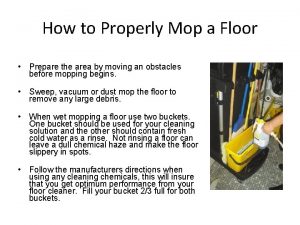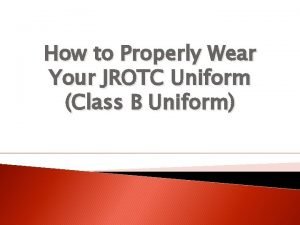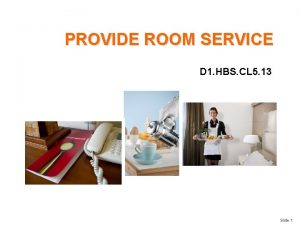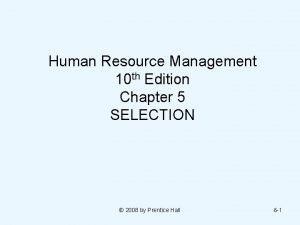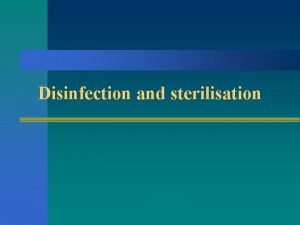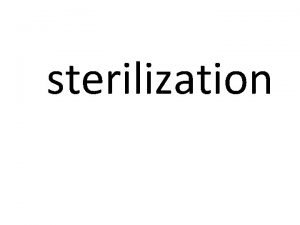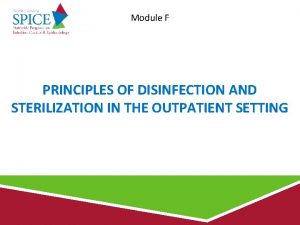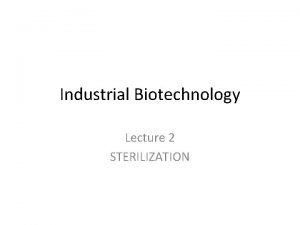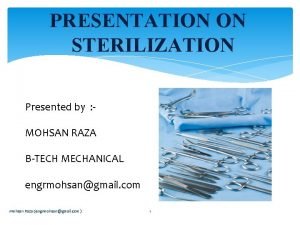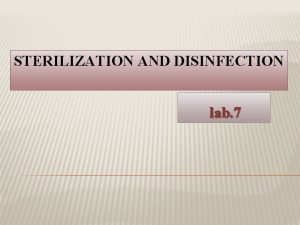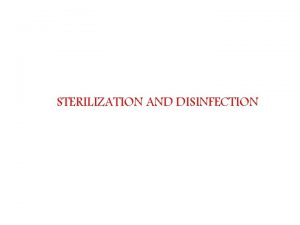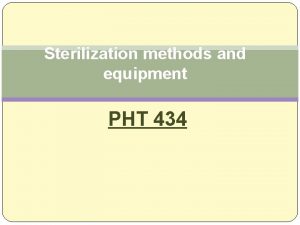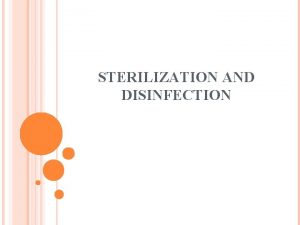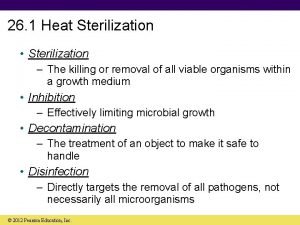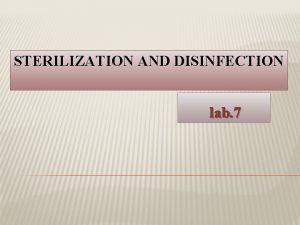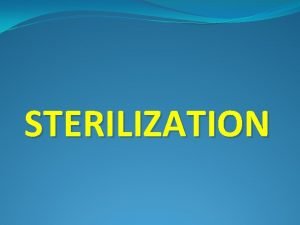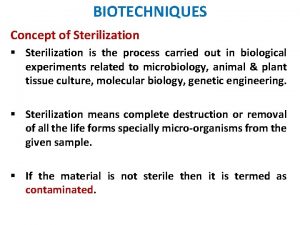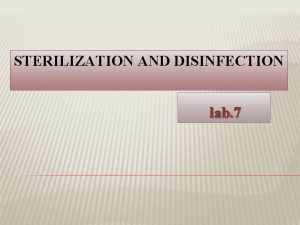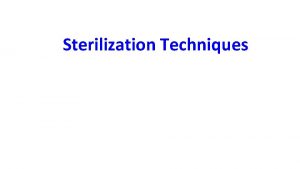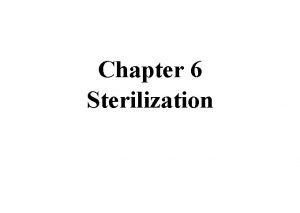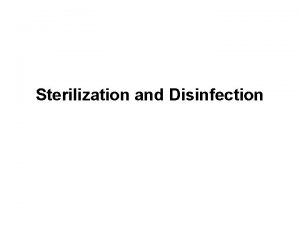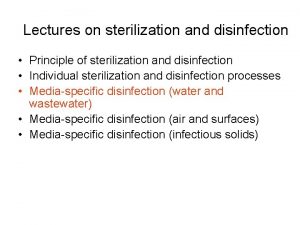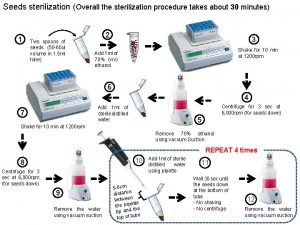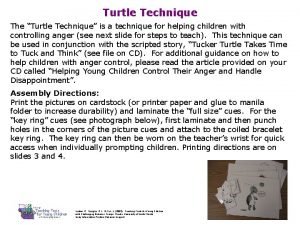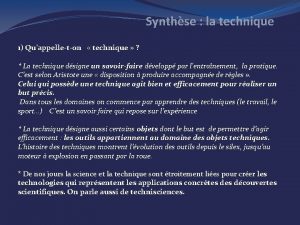Isolation Sterilization Technique 2 1 Isolation To properly























- Slides: 23


Isolation & Sterilization Technique 2

1. Isolation • To properly care for patients it is requiring isolation precautions. • The technologist must have a thorough understanding of the cycle of infection and methods to halt transmission of disease. 3

1. A Isolation Technique • Isolation technique is a care protocol designed to prevent the spread of disease from a patient diagnosed with a specific contagious disease to other patients and healthcare workers. • The technologist must have good communication skills and demonstrate caring, dignity and respect for the patient requiring isolation. 4

1. A Isolation Technique • The type of isolation technique is determined by the method in which a disease can be spread • Strict isolation precautions are required when airborne, droplet, and contact precautions are all required to prevent the spread of disease • Reverse or protective isolation is a type of strict isolation used when caring for patients with lowered immunity. 5

1. B Precaution in Isolation • In a reverse or protective isolation environment The technologist must be cautious and apply strict isolation precautions as: ØClean all equipment, including the mobile, before entering the patient’s room. ØWear all protective gear to protect the patient from exposure to pathogens. 6

1. B Precaution in Isolation Routine practice 7 Transmission based precaution By using both sets of precautions correctly one ensures that patients and health care workers are protected from exposure to the disease

1. C Isolation Technique – Patient Considerations • The technologist must be sensitive to the isolated patient’s feelings. • Be sure to explain procedures to the patient and communicate in an empathetic manner. 8

1. C. 1 Isolation Room Sign When patients are placed in isolation, a card identifying the precautions required to enter the patient’s room is posted on the door. 9

1. D Perform Radiography In Isolation Room • Before entering an isolation unit, the technologist must identify the type of isolation precautions indicated on the isolation sign. • Obtain the necessary supplies to perform the examination. 10

1. D Perform Radiography In Isolation Room Two technologists are preferable Contaminated and clean technologists role Use Image Receptor cover Perform all preparation out of the room (put receptor cover). Method of wearing and place of removing PPE is essential (ask the nurse for where). 11

1. D Perform Radiography In Isolation Room • Technologist A Ø Responsible for direct patient contact including positioning of the patient and the image receptor. Ø This technologist may be referred to as the “contaminated” technologist. • Technologist B Ø Has no direct contact with the patient, bed or any articles within the patient’s room, and may be referred to as the “clean” technologist. Ø This technologist handles the x-ray equipment and any image receptors not in a protective cover. 12 What about if there is only one technologist? !

1. E Perform Procedure In Medical Imaging Department • Bed or wheelchair should be covered with protective sheet and then blanket to cover the patient. • Type of isolation would determine PPE of patient, escort, technologist. • Room should be ready before patient arrive. Infectious patient must not wait in the corridor. • Sign must be placed on room’s door upon patient arrival. • Room must not be used for another patient till thoroughly cleaned. 13

2. Surgical Asepsis (Sterilization) • Surgical asepsis is a process that ensures the complete removal of all microorganisms from objects used to perform patient procedures. • Surgical aseptic techniques must be applied by the technologist in the operating room and in everyday practice (venipuncture, tubes and lines, sterilized procedures). 14 Biopsy Angio Urethrogram

2. A Sterilization’s Methods 1. Autoclave Moisture Pressurized steam. Quick sterilization • For items withstand high temperature. Towel, Metal, Glass • 2. Dry heat Uses dry heat with high temperature. long sterilization 6 Hours • Used for instruments, powder, greasy substance • 3. Gas (Freon ethylene oxide) 4. Chemical 15 Uses gas for items can not stand heat, pressure, moisture • Rubber, electronics. Poisonous gas so it needs aeration • 5. Commercial Ionizing Radiation

2. B Hand wash for sterile field • Normal hands wash is 15 -30 seconds. • Technologist enter operating room (OR) to perform radiography should wash hands for 3 minutes. • A surgical scrub is a hand washing procedure designed to remove as many microorganisms as possible from the hands and forearms using friction and chemical antiseptics (It takes not less than 5 minutes). 17

2. C Gowning • The technologist who is assisting with a sterile procedure may dress in sterile gown, sterile gloves, mask and booties. • • • 18 Hold it from shoulders area. Shake it gently. Insert sleeves but keep hands inside. Assistant to pull it back from behind. Adjust yourself. Rotate while someone hold the tighten robe with paper.

2. D Gloving q Putting gloves on: • Glove dominant hand first. • Hold from inside of the glove. • Keep hand clasp above waist. q Removing gloves: • Hold it from outside. • Roll it and keep in other hand. • Hold second glove from inside and roll it around first glove and through it. 19

2. E Maintain Sterile Field 20

2. F Sterilized Technologist Open sterile kit Preparing a sterile drape Adding sterile item to sterile field Pouring sterile solution 21

2. G Skin Preparation • Clean in toward periphery. • Do not allow antiseptic cleanser to collect beneath the patient which can cause skin irritation. • Do not return back over the area already cleaned with the same gauze. • Inspect the skin for signs of irritation. If redness or irritation is noted the area should be rinsed with saline and the radiologist notified. 22

Questions !! Any Questions ? 23

24
 How to mop the floor properly
How to mop the floor properly How is the nameplate worn on your uniform
How is the nameplate worn on your uniform Integrate quotes
Integrate quotes Introduction examples for essays
Introduction examples for essays Xml elements must be properly nested
Xml elements must be properly nested Set up trays and trolleys
Set up trays and trolleys How to cite a quote from a book
How to cite a quote from a book How does shampoo draping differ from chemical draping
How does shampoo draping differ from chemical draping Legal ethical and societal issues
Legal ethical and societal issues To stay properly hydrated a person
To stay properly hydrated a person Work cited page example
Work cited page example Characteristics of properly designed selection tests
Characteristics of properly designed selection tests Forced sterilization
Forced sterilization Physical and chemical methods of sterilization slideshare
Physical and chemical methods of sterilization slideshare What is sterilization
What is sterilization Chemster medical clinic
Chemster medical clinic Sterilization and disinfection
Sterilization and disinfection Sterilization
Sterilization Heating method of food preservation
Heating method of food preservation Package sterilization
Package sterilization Define sterilization slideshare
Define sterilization slideshare Process of sterilization
Process of sterilization Tass eye syndrome
Tass eye syndrome Labeled hot air oven diagram
Labeled hot air oven diagram
